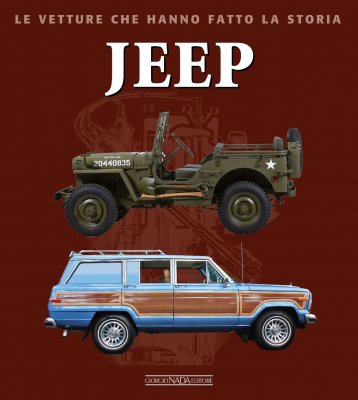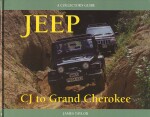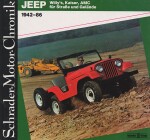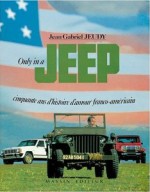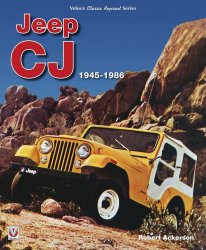We are exhibiting in Bologna: due to our participation in the ‘Auto Moto d'Epoca’ exhibition in Bologna (from 23 October to 26 October), orders will be shipped from 27 October. Thank you for your understanding. More information >>
We are exhibiting in Bologna: due to our participation in the ‘Auto Moto d'Epoca’ exhibition in Bologna (from 23 October to 26 October), orders will be shipped from 27 October. Thank you for your understanding. More information >>
The American general Dwight Eisenhower, who was to become President of the United States, said on more than one occasion that the Jeep was the weapon that permitted the Allies victory over the Axis forces in the Second World War, on all fronts and in all situations. The Jeep was born to satisfy the American army’s precise request for mobility; it was an innovative vehicle for its time, one that introduced a new concept of military mobility and was testimony to defeats and victories at all altitudes and in every climactic condition. At the end of the Second World War, the Jeep was adapted to agricultural and industrial work, being given the CJ (Civilian Jeep) designation that it was to maintain over a number of successful decades and series. Shortly after the end of the war, the MB provided the cue for the creation in parallel of a range of multi-purpose vehicles, including a station wagon, a pick up and a commercial van, that guaranteed the survival of the Willys Overland company. The Jeep did suffer moments of industrial crisis, financial vicissitudes and changes in ownership that began in the Eighties when AMC was sold to Renault, then Daimler Chrysler and then an investment fund, before Chrysler finally joined the Fiat group.
This book covers this long and complicated story, through to the 1980s, drawing on meticulous historical research, a rich photographic survey and technical files detailing the principal models.
Product specification
Additional information
Write a Review
Login or Register to write your review
You might also like
- Publisher: Motorbooks International
- Language: English
- Binding : In paperback
- Publisher: Amberley Publishing
- Language: English
- Binding : In paperback
- Publisher: E.t.a.i.
- Language: French
- Binding : In hardback
- Publisher: Motor Racing Publications
- Language: English
- Binding : In hardback
- Publisher: Schrader
- Language: German
- Binding : In hardback
- Publisher: Massin
- Language: French
- Binding : In hardback
- Publisher: Veloce
- Language: English
- Binding : In paperback
Per offrirti la miglior esperienza di navigazione possibile www.gilena.it utilizza i cookie. Vedi Informativa completa.
Preferenze sui cookie
Cookie essenziali
Utilizzati per le funzionalità vitali del sito, per garantire un esperienza utente ottimale
Cookie opzionali
Per funzionalità relative al marketing, alle statistiche e tutte quelle non ritenute essenziali
-
Shop by Category
Shop by Category
- Bus
-
Cars
Cars
- View all: Cars
- American cars
-
By marque
By marque
- View all: By marque
- Abarth
- Ac
- Alfa romeo
- Allard
- Alpine
- Alvis
- Alvis
- Amc
- Amilcar
- Amx
- Armstrong siddeley
- Asa
- Aston martin
- Ats
- Auburn-cord
- Audi
- Austin
- Austin healey
- Auto union
- Autobianchi
- Ballot
- Bentley
- Bianchi
- Bizzarrini
- Bmc
- Bmw
- Bolwell
- Bond
- Borgward
- Brabham
- Bristol
- Brm
- Bsa
- Bucciali
- Bugatti
- Buick
- Cadillac
- Chaparral
- Chenard & walker
- Chevelle
- Chevrolet
- Chevron
- Chrysler
- Citroen
- Cooper
- Cord
- Corvette
- Crossle
- Cunningham
- Daewoo
- Daf
- Daimler
- Dallara
- Datsun/nissan
- Db
- De dion-buton
- De lorean
- De soto
- De tomaso
- Delage
- Delahaye
- Diatto
- Dkw
- Dodge
- Duesenberg
- Edsel
- Elva
- Era
- Ermini
- F.a.t.a.
- Facel vega
- Farman
- Ferrari
- Fiat
- Ford
- Frazer nash
- Gaz
- Giannini
- Ginetta
- Glas
- Gm
- Gordini
- Gta
- Henney
- Hillman
- Hispano - suiza
- Hommell
- Honda
- Horch
- Hotchkiss
- Hudson
- Humber
- Impala
- Imperial
- Innocenti
- Isorivolta
- Isotta fraschini
- Itala
- Jaguar
- Jensen
- Jowett
- Koenigsegg
- Lagonda
- Lamborghini
- Lancia
- Lea-francis
- Lexus
- Life racing engines
- Limousine
- Lincoln
- Lola
- Lotus
- March
- Marcos
- Martini
- Maserati
- Matra
- Maybach
- Mazda
- Mclaren
- Mep
- Mercedes
- Mercury
- Messerschmitt
- Metro
- Mg
- Minerva
- Mini
- Mitsubishi
- Monica
- Morgan
- Morris
- Nash
- Nissan
- Nota
- Nsu
- Oldsmobile
- Om-iveco
- Opel
- Packard
- Pagani
- Panhard
- Panoz
- Panther
- Parnelli
- Pegaso
- Peugeot
- Pilain
- Pininfarina
- Plymouth
- Pontiac
- Porsche
- Puch
- Railton
- Range rover
- Reliant
- Renault
- Riley
- Rolls royce
- Rover
- Royale
- S.p.a.
- Saab
- Salmson
- Sauber
- Schweizer
- Seat
- Shelby
- Simca
- Singer
- Skoda
- Standard
- Steyr
- Studebaker
- Subaru
- Sunbeam
- Talbot
- Tatra
- Tecno
- Thunderbird
- Tiger
- Toyota
- Trabant
- Triumph
- Tvr
- Van diemen
- Vanwall
- Vauxhall
- Vedette
- Venturi
- Voisin
- Volkswagen
- Volvo
- Wanderer
- Wartburg
- Westfield
- Williams
- Willys
- Wolseley
- Car shows and museums
- Cars for kids
-
Coachbuilding, styling & design
Coachbuilding, styling & design
- View all: Coachbuilding, styling & design
- Alfa romeo
- Antem
- Asa
- Autodelta
- Bertone
- Bertoni flaminio
- Bmw
- Boneschi
- Brawand dany
- Campana
- Carcerano piero luigi
- Chappe & gessalin
- Chapron henri
- Charbonneaux philippe
- Cisitalia
- Colani luigi
- Colani lutz
- De tomaso
- Exner virgil
- Fioravanti leonardo
- Fissore
- Frua pietro
- Ghia
- Gilco
- Giugiaro
- Hebmuller
- Kellner
- Lancia
- Mantegazza
- Martin paolo
- Mathis emile
- Mays j
- Mercedes
- Michelotti giovanni
- Monteverdi
- Moretti
- Nissan
- Pininfarina
- Renault
- Reutter
- Riva
- Saab
- Saoutchik
- Sartorelli
- Sbarro franco
- Scaglietti
- Scioneri
- Siata
- Spada
- Stanguellini
- Touring
- Toyota
- Vignale
- Viotti
- Volkswagen
- Welter gerard
- Zagato
- Comics and drawings
- Yearbooks
- Collectibles
- Dvd & vhs
-
Manuals - technical books
Manuals - technical books
-
Military vehicles
Military vehicles
- Modelling
-
Motor sport and racing
Motor sport and racing
- View all: Motor sport and racing
-
Cars
Cars
- View all: Cars
- Aintree
- Autodromo di franciacorta
- Autodromo di pergusa
- Bahrain
- Birmingham
- Boavista
- Brands hatch
- Bridgehampton
- Brno
- Brooklands
- Buenos aires
- Can am
- Carrera panamericana
- Castle combe
- Charade
- Circuito del garda
- Circuito del jarama
- Circuito del mugello
- Circuito del valentino
- Circuito di cremona
- Circuito di lasarte
- Circuito di modena
- Circuito di napoli
- Circuito di pescara
- Circuito di piacenza
- Circuito di rouen les-essarts
- Coppa acerbo
- Coppa della perugina
- Coppa etna
- Coppa gordon bennett
- Coppa paolino teodori
- Corse in salita
- Dieppe
- Formula 1
- Formula 2
- Formula 3
- Formula 3000
- Formula 5000
- Formula ford
- Formula junior
- Francorchamp
- Giro di sicilia
- Goodwood
- Gran premi belgio
- Grand prix
- Hockenheim
- Imola
- Indianapolis
- Interlagos
- Kart
- Le mans
- Macau
- Martini racing
- Mille miglia
- Mintex
- Montjuic
- Montlhery
- Monza
- Nascar
- Nassau
- Nurburgring
- Oulton
- Paul-ricard
- Penya rhin
- Phillip island
- Rally
- Reims
- Sebring
- Silverstone
- Solitude
- Stock car
- Targa florio
- Tasman cup
- Thruxton
- Torrey pines
- Trans-am
- Vallelunga
- Vila real
- Westwood
- Zandvoort
- Zolder
- Motorcycles
- Paris-dakar
- Record
-
Motorcycles
Motorcycles
- View all: Motorcycles
-
By marque
By marque
- View all: By marque
- Aermacchi
- Ajs
- Ajs & matchless
- Ape
- Aprilia
- Ardie
- Ariel
- Benelli
- Beta
- Bimota
- Bmw
- Brough superior
- Bsa
- Bultaco
- Cagiva
- Ccm
- Cz
- Demm
- Derbi
- Dkw
- Douglas
- Ducati
- Egli
- Frera
- G.d
- Ganna
- Garelli
- Gilera
- Gitane
- Gori
- Guzzi
- Harley davidson
- Hercules
- Honda
- Horex
- Husqvarna
- Indian
- Jap
- Jawa
- Kawasaki
- Kreidler
- Ktm
- Lambretta
- Laverda
- Maico
- Maserati
- Matchless
- Mba
- Mm
- Mondial
- Monet goyon
- Montesa
- Morbidelli
- Morini
- Motobecane
- Mv agusta
- Mz
- Neftali ollearo
- Norton
- Nsu
- Opel
- Ossa
- Panther
- Parilla
- Peugeot
- Piaggio
- Puch
- Royal enfield
- Rudge
- Rumi
- Sanglas
- Sarolea
- Scott
- Sertum
- Sunbeam
- Suzuki
- Terrot
- Triumph
- Velocette
- Vespa
- Victory
- Vincent
- Wanderer
- Yamaha
- Zundapp
- Chopper
- Comics and drawings
- Sidecar
- Trike
- Yearbooks
- Off road
- Other subjects
-
Personality & driver
Personality & driver
- View all: Personality & driver
-
Car drivers
Car drivers
- View all: Car drivers
- Alboreto michele
- Alen markku
- Alesi jean
- Amon chris
- Andretti mario
- Ascari
- Bandini ilario
- Bandini lorenzo
- Barrichello rubens
- Bell derek
- Berger gerhard
- Biason miki
- Brabham jack
- Burns richard
- Caracciola rudolf
- Castellotti
- Clark jim
- Conrero
- Coulthard david
- Courage piers
- Darniche bernard
- De filippis maria teresa
- De Portago
- Dean james
- Fangio
- Fittipaldi emerson
- Frentzen heinz-harald
- Gurney dan
- Hakkinen mika
- Hawthorn mike
- Hill damon
- Hill graham
- Hunt james
- Ickx jacky
- Laffite jacques
- Lauda niki
- Loeb sebastien
- Mairesse willy
- Mansell nigel
- Marzotto
- Mckay david
- Mclaren bruce
- Mcqueen steve
- Mcrae colin
- Montoya juan pablo
- Moss stirling
- Musso luigi
- Nardi
- Nesti mauro
- Nuvolari tazio
- Peterson ronnie
- Pilette
- Piquet
- Pironi didier
- Prost alain
- Ragnotti jean
- Rainey joy
- Regazzoni clay
- Reutemann carlos alberto
- Rindt jochen
- Rohrl walter
- Rondeau jean
- Rosemeyer
- Rosier louis
- Russell jim
- Sainz carlos
- Sartarelli francesco
- Schumacher michael
- Scott brown archie
- Seaman richard
- Senna ayrton
- Serafini dorino
- Stewart jackie
- Stohl rudi
- Stohr siegfried
- Taruffi piero
- Toivonen henri
- Trips wolfgang von
- Vaccarella nino
- Varzi achille
- Villeneuve gilles
- Villeneuve jacques
- Villoresi luigi
- Von hanstein huschke
- Wimille jean-pierre
- Zanardi alex
- Magazines
-
Motorcycle drivers
Motorcycle drivers
- View all: Motorcycle drivers
- Agostini giacomo
- Anderson hugh
- Ballington kork
- Bandirola carlo
- Bayliss troy
- Benelli tonino
- Bergamonti angelo
- Biaggi max
- Bianchi edoardo
- Bianchi pier paolo
- Britten john
- Buscherini otello
- Capirossi loris
- Cau giuseppe
- Conti vittorio
- Dobb jamie
- Duke geoff
- Dunlop joey
- Dunlop robert
- Edwards colin
- Ermolenko sam
- Everett reg
- Finnegan martin
- Fogarty carl
- Gritti alessandro
- Hailwood mike
- Hannah bob
- Ivy bill
- Lazzarini enzo
- Lomas bill
- Lorenzo jorge
- Lucchinelli marco
- Mandracci guido
- Marquez marc
- Masetti umberto
- Mcgrath jerry
- Mcintyre bob
- Meier georg
- Miller sammy
- Muller egon
- Neumann-neander ernst
- Ostorero emilio
- Parlotti gilberto
- Pasolini renzo
- Penhall bruce
- Provini tarquinio
- Rainey wayne
- Read phil
- Rossi valentino
- Ruffo bruno
- Seeley colin
- Sheene barry
- Simoncelli marco
- Spencer freddie
- Stoner casey
- Surtees john
- Tenni omobono
- Testori imerio
- Vincent arnaud
- Wilkinson arthur george
- Personality
-
Tractors & caterpillar
Tractors & caterpillar
- View all: Tractors & caterpillar
- Caterpillar
-
Tractors by marque
Tractors by marque
- View all: Tractors by marque
- Allgaier
- Allis-chalmers
- Bubba
- Caterpillar
- Cletrac
- Cockshutt
- David brown
- Deutz
- Eicher
- Farmall
- Ferguson
- Fiat
- Ford
- Fordson
- Hanomag
- Hart-parr
- Holt
- International harvester
- J.i. case
- John deere
- Kramer
- Landini
- Lanz
- Marshall
- Massey
- Minneapolis-moline
- Nuffield
- O.m.
- Oliver
- Perkins
- Porsche
- Renault
- Same
- Steyr
- Tractractor
- Twin city
- Trucks
- [ Gift Cards ]
- New Releases
- Special Offers
-
Latest Additions
Latest Additions
- coming soon
- Events
- Account
-
Information
Information
Limited Stock Books
We generally have one or more copies of this book available: they may be in perfect condition or with some signs of wear, the price may vary depending on the state of conservation.
Please, contact us for information on the state of conservation and the selling price of this product.




